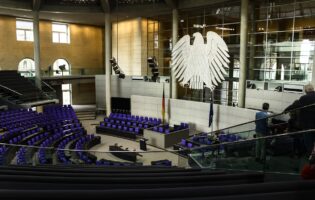German Bashing and a French-German Art Controversy

Frank Trommler
University of Pennsylvania
Frank Trommler is Professor Emeritus of German at the University of Pennsylvania, where he has been a member of the Department of Germanic Languages and Literatures since 1970. He has taught courses in German language, literature and culture in the nineteenth and twentieth centuries and, since 1985, also in Comparative Literature. He chaired the Department in 1980-86 and several times since 1994 as acting chair. In 1996-2000 he also served as acting chair of Penn’s Department of Slavic Languages.
A Guggenheim Fellow in 1984/85, Trommler was President of the AATG chapter Philadelphia in 1986-1990, President of the German Studies Association in 1991/92, and Director of the Humanities Program at the American Institute for Contemporary German Studies in Washington, DC, from 1995-2003. In 1994 he was awarded the Bundesverdienstkreuz by the President of the Federal Republic for his work in the field of American-German relations.
His publications include Roman und Wirklichkeit (1965), Sozialistische Literatur in Deutschland (1976), Die Kultur der Weimarer Republik (1978, with Jost Hermand, several reprints), America and the Germans (1985, also in German), Germanistik in den USA (1989), Thematics Reconsidered (1995), The Cultural Legitimacy of the Federal Republic (1999), Berlin: The new Capital in the East (2000), The German-American Encounter (2001, also in German), Weimars transatlantischer Mäzen: Die Lincoln-Stiftung 1927-1934 (2008). In 1995-2003 he edited fourteen volumes of the AICGS Humanities Series on Contemporary German Studies. A Festschrift in his honor appeared in 2004 under the title, The Many Faces of Germany, edited by John McCarthy, Walter Grünzweig, and Thomas Koebner.
Emeritus professor since 2007, Trommler published the first comprehensive study of German cultural diplomacy with France, Britain, United States, Russia, Poland, and Italy in 2014 under the title, Kulturmacht ohne Kompass: Deutsche auswärtige Kulturbeziehungen im 20. Jahrhundert (Cologne: Böhlau).
In 2014 he received the honorary degree of Doctor of Modern Languages at Middlebury College, Vermont, at the occasion of the 100th anniversary of the Middlebury Language School which was founded by the German professor Lilian Stroebe in 1915. The event united over a hundred MA and PhD graduates of the summer immersion programs in ten languages.
German bashing is in. Commentators in Germany insist that it is used throughout Europe, especially in southern European countries, to divert attention from homegrown financial blunders. In fact, Germany is vilified as the originator of much of Europe’s misery, with references to the Second World War, and pictures of Angela Merkel donning a Hitler mustache. It is therefore no wonder that German commentators correlated their displeasure over a French exhibition of German art with this climate of anti-German sentiment and, in return, were rebuffed by French critics as malicious and wrong. The controversy is centered on the big art exhibition in the Louvre, entitled “De l’Allemagne, 1800-1939. De Friedrich à Beckmann.” Organized in celebration of the 50th anniversary of the Élysée friendship treaty between Charles de Gaulle and Konrad Adenauer, and under the patronage of Chancellor Merkel and President Hollande, the exhibit has become a catalyst for the prickly German reaction to a prominent reassessment of its culture at a time of political and economic tension. A critic in the Hamburg weekly Die Zeit, Thomas E. Schmidt, added to the headline “Der Hegemon” the line: “only culturally can other Europeans still contest the German dominance” (“Nur kulturell können die anderen Europäer die deutsche Vorherrschaft noch bestreiten,” Nr. 17, 18 April 2013). Does the widely discussed exhibition at the Louvre—the largest ever presentation of German art in France—represent part of this challenge?
The exhibition, on view from 28 March through 24 June 2013, shows two hundred works of art with an emphasis on the early nineteenth century, usually labeled Romanticism, and early twentieth century, usually labeled Modernism—part of the creative explosion after World War I. The entrance rotunda is impressively filled with eight huge panels of black and white woodcuts by Anselm Kiefer, mythologizing France’s neighbor Germany from the shores of the Rhine river—a stylish and successful introduction to this exhibition that was planned as a bi-national project but eventually curated fully by the Louvre (where German art usually does not rank high).
The show draws more visitors and presents more first-rate, or at least high-caliber, paintings than expected. Its agenda follows the French tradition of interpreting art in a political context, in this case that of nineteenth-century art tracing the awakening of the Germans as a nation through their Apollonian and Dionysian visual imagination. The exhibit guides the visitor from Tischbein’s famous Goethe-in-Italy painting and Caspar David Friedrich’s very best and very melancholic, if not bitter, landscapes to—and here is where German critics have taken issue with the French curators—a group of paintings by Franz von Stuck, Arnold Böcklin (a Swiss), and other nineteenth-century artists in whom the curators seemed to place the embodiment of the Dionysian spirit that can be linked to aggression and nationalist exuberance (following Richard Wagner). While French observers might make the connection, the German critics in Die Zeit, Frankfurter Allgemeine, Die Welt, and other papers do not. These same German critics also take issue with the emphasis on World War I (as if German artists needed it for inspiration); the suggestion of the path to National Socialism, including the canonical Leni Riefenstahl, ending the show with the year 1939 (although no painting of that year is shown); and, last but not least, the omission of Dada, the Blauer Reiter group, and Bauhaus (although Paul Klee, teacher at the Bauhaus, is well represented).
To its credit, Die Zeit where Adam Soboczynski expressed his objections (No 15, 4 April 2013) gave Louvre President Henri Lorette the opportunity to respond and explain the concept behind the exhibit’s design (No 17, 18 April). In a well argued piece, Lorette is right in rejecting the assumption that the paintings were selected as a demonstration of the sinister (das Unheimliche) in German art and spirit. He rightly emphasizes that the display’s second part is not pointing toward the Nazi disaster, but rather takes up Goethe’s universalism in his theory of colors (Farbenlehre). This is indeed a particularly strong part of the “other” view of German art: the inclusion of Goethe’s experiments with the effects of color from which a line could be drawn to Josef Albers and the Bauhaus theories on color. Furthermore, there are other points that illuminate a fascination with the “abundance, diversity, and creativity” of German art from the outside, a fascination that Lorette convincingly links to the uniquely expressive and impressive concern of German artists after World War I with the plight of the individual, culminating in Lovis Corinth’s moving “Ecce Homo” of 1925.
The controversy has a solid base in the misunderstandings and stereotyping of German-French cultural relations since the nineteenth century. The question here is how much the current European resentment against the economic and, to some extent, political dominance of the Federal Republic is resurrecting the stereotypes of earlier periods when German aggressiveness eliminated every foreign intention of recognizing the “abundance, diversity, and creativity” of German art that Henri Lorette wants to convey to the French public. Without doubt, his exhibition uses certain assumptions about the German mind that can be read as traditional clichés which do not do justice to what Germans believe has shaped artistic developments in their country. Associating the fighting male nudes of Franz von Stuck and Böcklin’s Toteninsel to the sinister streak in Germany does not present convincing evidence—the audio guide provides further poignant examples of such stereotyping. Nevertheless, the audience seems to shun this connection. French critics have also dismissed it, instead referring directly to the liberating effect of the display of pictures, as it shows how little German art and culture are known to the French observer.
The disconnect between the German anger about Lorette’s ambitious project and the substance of this unique exhibition of excellent examples of German art is striking. It can indeed be seen as an overreaction at a time of political tension regarding Germany’s role in Europe, but it deserves some explanation and reflection that point beyond the specifics of this event.
Most apparent in the German response is the immediate reference to what has been a staple of foreign reporting about German affairs in many forms: the perception of German culture as the accompaniment to the evil Bismarck-Wilhelm-Hitler progression. This notion has become the standard storyline of many foreign histories of modern Germany, foregrounding a sellout of culture and its descent into disaster. The French have used it with much gusto, as have Brits and Americans. And yet, it is not the gist of this Louvre exhibition. While the Louvre’s show uses certain stereotypes that may be routine in order to attract an audience, it refines the old French fascination for the strangeness of German art as an intriguing creation, one that stands apart from the French way of “solving” the strangeness of life by aesthetic pleasure. It is hard for a German observer to fully recognize and accept the fact that German “solutions”—which often consciously avoid the pleasure principle—do not reiterate the evil Bismarck-Wilhelm-Hitler scenario in the mind of the foreign observer, but rather display a memorable take on the human condition that is nowhere else to be found. Listening to foreign observers can provide an unexpected perspective, as it helps Germans understand and refine their own “solutions.” Foreign critics help outline the normality of cultural differences, objections, and misunderstandings within which Germans want to be seen as creators of a substantial part of European culture.
German cultural critics obviously have a difficult time working with the kind of review that places Germanic objects within the normality of cultural differences and misunderstandings. My point is not that the currently heightened tension does not trigger associations to the Bismarck-Wilhelm-Hitler line, but rather that there is very little give and take when German critics confront a sound critical assessment of an important part of their culture. If I see it correctly, the black-and-white response results from many decades of battling the Nazi legacy. Yet, it also betrays more of a general malaise in the current German response to the suspicions and critiques of their European neighbors.
Knee-jerk reactions are understandable when posters of Angela Merkel with a Hitler-mustache are burned. More disconcerting is when Germans lose interest in a deeply differentiated discussion of foreign perceptions of German affairs, be they cultural or political. For instance, the traditional explanation of the German motivation to embrace the European project—to anchor Germany unequivocally within a larger union—is now being challenged by Germany’s European neighbors as a veil covering up its ambition to legitimize its dominance over Europe. Such a belief should be most upsetting to German political elites, thereby causing them to collect and articulate a valid intellectual response that goes beyond the phrases which once created trust in Kohl’s European project. It might not be enough that Jürgen Habermas, in a recent speech to an overcrowded auditorium in Leuven, Belgium, warned the Berlin government to beware of hegemony in Europe. (“Merkel, Kohl und Europa,” Süddeutsche Zeitung Nr. 99, 29 April 2013).Warnings of this kind have a long tradition, yet they do not stir particular interest among other societies in the German predicament. They affect little when not leading to a sound response from the political leadership that would help clarify what is left of the much conjured European solidarity. At a time when the political leadership is unable or unwilling to bridge the growing chasm between the Federal Republic and its neighbors, intellectual elites should help reinforce existing bridges and engage constructively with the “other” views. They cannot refer to the federal election in fall 2013 as an excuse for reticence used by politicians.









